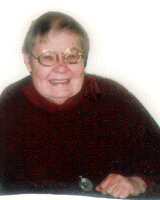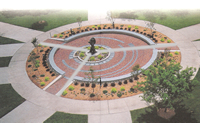
Dorothy Walters
is honored with a Brick from AlexSandra Leslie and LaNita Mark.

Dorothy Walters was born in 1928 in Edmond, Oklahoma. She joined her first writing circle in the first grade and went on, predictably, to take a Ph. D. in English literature when she grew up. During her adolescent years she delved into the great books (such as Emerson, Plato, Tolstory, Goethe and others). When she was still in high school she took courses in English at the local college (then called Central State Teachers College) where she met a teacher (Mollie Ruth Bottoms) who presented literature as a sacred occupation and who inspired Dorothy to devote her iife to the written word. She took her B. A. (with a najor in English) from the Univesity of Oklahoma at age 20. After an unfortunate experience in teaching English in a small town high school, as well as a stint as a librarian in Lubbock, Texas, and Bartlesville, Oklahoma, she returned to the University of Oklahoma in 1953, gaining her PHD (English and American literature) in 1960.
She then taught English as instructor and assistant professor at the University of Colorado for the next seven years, where she was elated by the scenery but disturbed by the constant wrangling among the higher faculty. However, she had come to Colorado with several friends, and they managed to enjoy themselves immensely dispite the disturbing political scene in the department.
In 1967 she took a position as Associate Professor in the English department at Wichita State University and very much enjoyed teaching the advanced students who were often “returning women” intent on making the most of their education as they sought to finish their degrees. Her primary teaching field was the modern novel by English and American writers. Ultimately, her focus was on women writers of the present era. She now developed a strong interest in the growing feminist movement and especially in the lore of the Great Mother. She particularly enjoyed visiting various classes to announce that originally “god was a woman” (Merlin Stone). These students were for the most part glad to receive this news, for they were eager to reclaim their full feminine identity.
In the mid seventies she and several of her colleages set up one of the earlier women’s studies programs in the country. She then became the coordinator for this program and served in that capacity until her retirement in 1988. The primary motto for this group (begun in defiance of many of the entrenched male faculty) was “forgiveness is easier to achieve than permission.” This program was highy successful with a gifted faculty with high achievement in all areas: teaching, researach, community service, cost. Nonetheless, the program was under constant fire and much time had to be devoted to its (successful) defence.
While she was at WSU, Dorothy published two books, one on the Southern writer Flannery O’Connor, the other a joint effort with Dr. Carol Konek. Together they created one of the first anthologies of women’s poetry to appear in print.
In 1981, when she was 53 years ol, an event occurred which changed her life forever. This event is known as spontaneous Kundalini awakening. One morning, as she was in a state of personal crisis (threatened breakup of a long term relationshp) she happened to be reading a book which mentioned Kundalini but did not describe it in detail. Although she had no prior knowledge or experience of this phenomenon, Dorothy, against all odds, managed to bring the inner energies up from the base to the crown. Her crown then opened in ecstatic delight as if all the sweet energies of the universe were flowing in (described in Eastern literature as if a thousand lotus petals were opening).
Before this time she had virtually no knowledge of eastern thought—she had never done yoga nor meditated nor practiced tai chi or chi gong—in fact, she had never even had a massage. Indeed, she was virtually ignorant of the existence of the inner energies. Traditionally, yogis must prepare for such awakenings for many years, practicing various stringent exercises, following a very strict diet, and studying ancient texts under the guidance of a guru. Dorothy had virtually no awareness of such practices and knowledge systems. For her, this awakening experience was the beginning of a long and sometimes difficult experience, with extreme bliss often alternating with painful symptoms as her body sought to accommodate and integrate these new sensations. This process of adjustment continued in modified form for the rest of her life, though in recent years her system has almost fully settled down. At the beginning, the feelings were like a great thunder and lightning storm tearing open the sky. Now, over thrity years later, they continue In more subtle form ,more like a gentle rain falling on spring leaves.
Those who undergo such awakenings are usually advised to find a qualified teacher or guru to guide them through these unfamiliar states of consciousness, but at that time in Kansas (and in much of the rest of the country) such teachers were not available. Further, there were few people in her worlld who had even heard of Kundalini, so she did not even have a friend to share her experiences with. Thus with no external direction or help outside a few basic texts, Dorothy went through a very long period of adjustment on her own. She did, however, keep a journal and this became the basis for her spiritual autobiography which was published several years later (see below).
During this time, she was able to offer a course in “Personal and Social Transformation” in which students were introduced to various states of expanded consciousness, including such topics as quantum physics and the nature of psychic and spiritual experiences.
In 1988 a great wind blew Dorothy out of Kansas and into San Francisco where she lived for 21 years until she moved back to Boulder in 2009. In San Francisco she mett an outstanding spiritual teacher (Andrew Harvey, major writer on Rumi and the Divine Feminine) who was among the first to honor her story and to inspire her to write sacred poetry. Under his inspiration and guidance, she has published several books of mystical poetry as well as the spiritual memoir mentioned above. These poems appeal to those who like Rumi or who have undergone significant spiritual transformation in their own lives. She has also published a spiritual memoir as mentioned above, which describes her own experience of spontaneous Kundalini awakening and its continuing refinements. This book is now considered a major contribution to the literature of Kundalini, both as phenomenon and personal experience.
Because she has observed and felt the dramatic changes that Kundalini has brought in her own life, she considers Kundalini to be the driving force behind the process of universal spiritual awakening now occurring across the planet. Like Gopi Krishna and others, she believes that Kundalini is the primary engine of the evolution of human consciousness predicted by many, and that we are now witnessing and experiencing its power.
To help others on the spiritual path, she publishes an internet blog at www.kundalinisplendor.blogspot.com (Poems and Reflections on the Spiritual Journey). There she presents her own poems and writings as well as those of others, and is available to teach, assist, and support those going through the mysteries of Kundalini Awakening and profound spiritual transformation. Though she did not share her experience with others for many years, she now offers such help to many, as her way of “bringing the gift back home” (Joseph Campbell, from The Hero’s Journey).
A lifelong lesbian, she is also a self-identified mystic, even though both of these categories tend to bother some people. In a strange way, she finds them ultimately connected. For many years, her primary relationship has been with “The Beloved Within,” who has brought her so much joy and inspiration in her life.
Now in her eighties (as of 2014), Dorothy feels that she was blessed to be in the forefront of so many social transformations. She took a Ph. D. and subsequently became a college professor when women were not encouraged to go this route. She was one of the earliest feminists and encouraged others on this path. She was a lesbian before this life style became popular. She taught women’s literature when it was still unrecognized by many. She experienced Kundalini awakening before it was widely known in this country.
She now lives quietly in Colorado and enjoys watching the mountains as they reflect the changing seasons. She continues to write poetry and publish her blog, and often corresponds with persons around the world who are undergoing Kundalini transformation.
Boulder, Colorado
July, 2014
Dorothy’s publications—all the following recently published available on Amazon
Poetry:Marrow of Flame: Poems of the Spiritual Journey (2000) (Intro by Andrew Harvey)
A Cloth of Fine Gold: Poems of the Inner Journey (2008)
The Ley Lines of the Soul: Poems of Ecstasy and Ascension (2012)
Penelope’s Loom: Poems of Turning Matter into Spirit (2012)
Memoir:Unmasking the Rose: A Record of a Kundalini Initiation (2002) (Intro by Andrew Harvey)
(All of the above were published in Dorothy’s seventies and eighties)
The following were publlished earlier in her career:Flannery O’Connor (published when O’Connor was little known as a writer—she has since become world famous)
I Hear My Sisters Saying : Poems by Twentieth Century Women (This anthology, co-edited with Dr. Carol Konek, was one of the first collections of poetry by women to appear in print.)










